
The pancake batfish, Atlantic pancake batfish, Louisiana pancake batfish or spiny batfish, is a species of marine ray-finned fish belonging to the family Ogcocephalidae, the deep sea batfishes or seabats. This species is found in the Western Atlantic Ocean.

Ogcocephalidae is a family of anglerfish specifically adapted for a benthic lifestyle of crawling about on the seafloor. Ogcocephalid anglerfish are sometimes referred to as batfishes, deep-sea batfishes, handfishes, and seabats. They are found in tropical and subtropical oceans worldwide. They are mostly found at depths between 200 and 3,000 m, but have been recorded as deep as 4,000 m (13,000 ft). A few species live in much shallower coastal waters and, exceptionally, may enter river estuaries.

Ogcocephalus vespertilio, the Brazilian batfish or seadevil, is a species of marine ray-finned fish belonging to the family Ogcocephalidae, the deep sea batfishes. This species is found in the Western Atlantic Oceean. The Brazilian batfsish is the type species of the genus Ogcocephalus.

Ogcocephalus parvus, the roughback batfish, is a species of marine ray-finned fish belonging to the family Ogcocephalidae, the batifishes. This species has a wide distribution in the Western Atlantic Ocean.
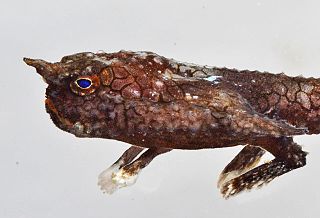
Malthopsis, the gnome batfishes or triangular batfishes, is a genus of marine ray-finned fishes belonging to the family Ogcocephalidae, the deep sea batfishes. The triangular batfishes are distributed throughout the warmer waters of the world, although they are absent from the Eastern Atlantic Ocean. The genus was originally proposed in 1891 by the British naturalist Alfred W. Alcock.

Dibranchus is a genus of marine ray-finned fishes belonging to the family Ogcocephalidae, the deep sea batfishes. The fishes in this genus are widely distributed in the Atlantic, Indian and Pacific Oceans.
Solocisquama is a genus of marine ray-finned fishes belonging to the family Ogcocephalidae, the deep sea batfishes. The species in this genus are benthic fishes found in deep waters in the Indian and Pacific Oceans.

Zalieutes is a genus of marine ray-finned fishes belonging to the family Ogcocephalidae, the deep sea batfishes. The species in this genus are benthic fishes found in deep waters in the Western Atlantic and Eastern Pacific Oceans.

Ogcocephalus radiatus or the polka-dot batfish is an arrow-shaped fish in the family Ogcocephalidae with an elongated thin tail. It is dorso-ventrally flattened with round pectoral fins that sit flat on the bottom of the sea floor. It uses its pectoral fins and pelvic fins to "walk" along the bottom in a side-to-side shuffling motion.
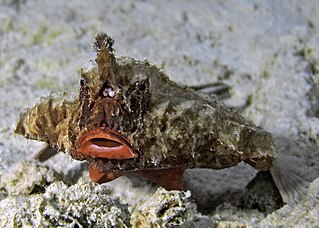
Ogcocephalus corniger, the longnose batfish, is a species of ray-finned fish belonging to the family Ogcocephalidae, the deep sea batfishes. This fish is found at depths between 29 and 230 m in the Atlantic Ocean, ranging from North Carolina to the Gulf of Mexico and the Bahamas. Like other members of the family Ogcocephalidae, it has a flat triangular body with coloring varying from yellowish to purple with pale, round spots. The lips are orange-red. Projecting from its head is a characteristic structure that is shared by other anglerfish.
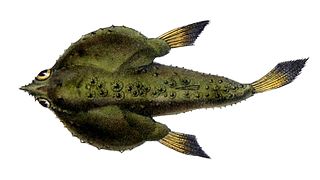
Ogcocephalus notatus, the marked batfish, is a species of ray-finned fish belonging to the family Ogcocephalidae, the deep sea batfishes. It is found in the tropical western Atlantic Ocean.
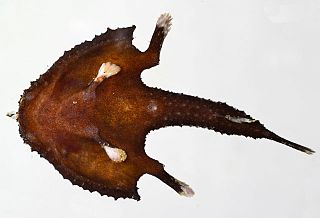
Malthopsis gnoma, the Atlantic triangular batfish, gnome seabat or grotesque seabat, is a species of marine ray-finned fish belonging to the family Ogcocephalidae, the deep-sea batfishes. The grotesque seabat is found in the Western Atlantic Ocean, in the Gulf of Mexico and Caribbean.
Ogcocephalus porrectus, the rosy-lipped batfish, is endemic to Cocos Island off the Pacific coast of Costa Rica. Though members of Ogcocephalidae occur in tropical, warm waters in both the Western Atlantic and Eastern Pacific. Rosy-lipped batfish generally reside in shallow to deep water benthic zones with a bathymetric range of 35 – 150 m. The syntypic series was collected at 120 m on a rocky bottom. What makes this fish distinctive are its rosy red lips, specialized pectoral fins used for "walking", and an illicium used for attracting prey.
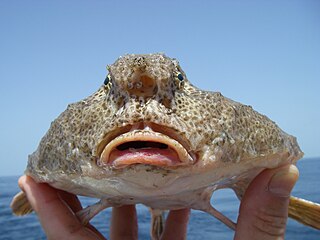
Ogcocephalus declivirostris, the slantbrow batfish, is a species of ray-finned fish belonging to the family Ogcocephalidae, the deep sea batfishes. This species is found in the western Atlantic Ocean from the northern Gulf of Mexico to the Straits of Florida.

Ogcocephalus pantostictus, the spotted batfish, is a species of ray-finned fish belonging to the family Ogcocephalidae, the deep sea batfishes. It is found in the western Atlantic Ocean, somewhat restricted to the northern and the western Gulf of Mexico.
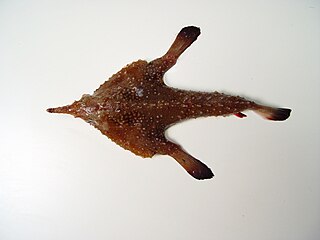
Ogcocephalus pumilus, the dwarf batfish, is a species of ray-finned fish belonging to the family Ogcocephalidae, the deep sea batfishes. It is found in the western Atlantic Ocean. It is the smallest species in the genus Ogcocephalus.
Ogcocephalus rostellum, the palefin batfish, is a species of ray-finned fish belonging to the family Ogcocephalidae, the deep sea batfishes. It is found in the western Atlantic Ocean.

Ogcocephalus cubifrons, the spotted batfish or polka-dot batfish, is a species of ray-finned fish belonging to the family Ogcocephalidae, the deep sea batfishes. This is an uncommon demersal fish found in the Western Atlantic Ocean and the southern Gulf of Mexico, in the United States, Mexico and the Bahamas.

Ogcocephalus nasutus, the shortnose batfish, is a species of ray-finned fish belonging to the family Ogcocephalidae, the deep sea batfishes. This species is found in the western Atlantic Ocean and the Caribbean.
Malthopsis bradburyae, Bradbury's triangular batfish, is a species of marine ray-finned fish belonging to the family Ogcocephalidae, the deep-sea batfishes. This little known species is found in the western Indian Ocean off Tanzania and is named in honour of the American ichthyologist Margaret G. Bradbury.


















